Analyzing the Economic Impact of the USA-China Trade War on Australia
VerifiedAdded on 2022/10/18
|7
|1732
|18
Essay
AI Summary
This essay examines the trade war between the USA and China, focusing on China's responses and the impacts on the Australian economy. It begins by outlining the initiation of the trade war due to protectionist policies by the U.S. and China's retaliatory tariffs on U.S. goods. The analysis covers China's diplomatic efforts, including negotiations and complaints to the WTO, as well as internal policies like import substitution and interest rate adjustments. The essay further explores the short-term benefits and potential long-term risks for Australia's economy, highlighting the importance of the US-China trade relationship for the global economy. The study concludes that while Australia may experience short-term gains, the long-term consequences of a disrupted global value chain could negatively affect its economic stability. Desklib offers this essay and numerous other resources for students seeking to understand complex economic issues.
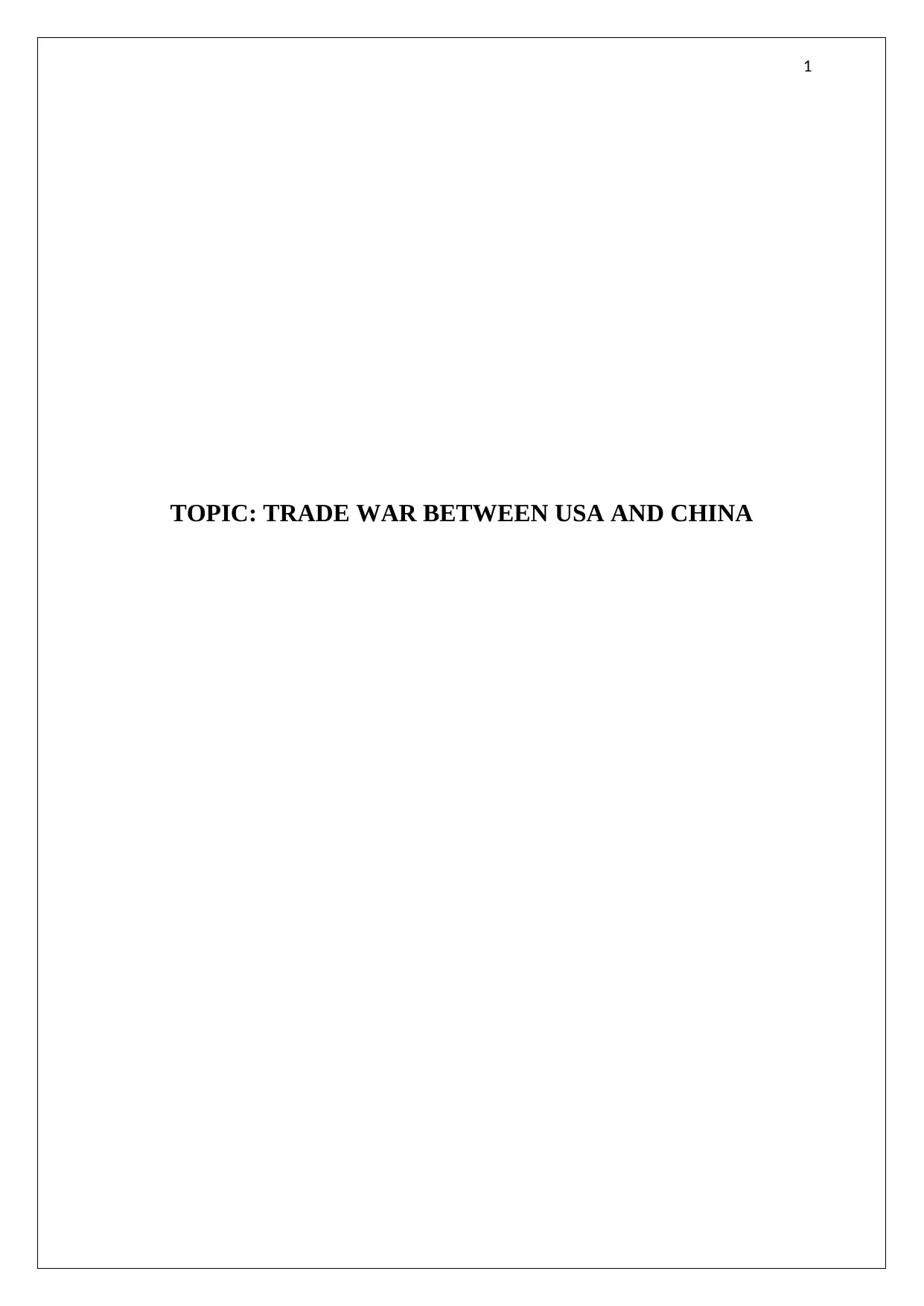
1
TOPIC: TRADE WAR BETWEEN USA AND CHINA
TOPIC: TRADE WAR BETWEEN USA AND CHINA
Paraphrase This Document
Need a fresh take? Get an instant paraphrase of this document with our AI Paraphraser

2
Contents
Introduction................................................................................................................................3
China’s response to the trade war..............................................................................................3
Impacts of the trade war on Australia’s economy......................................................................5
Conclusion..................................................................................................................................5
Reference....................................................................................................................................7
Contents
Introduction................................................................................................................................3
China’s response to the trade war..............................................................................................3
Impacts of the trade war on Australia’s economy......................................................................5
Conclusion..................................................................................................................................5
Reference....................................................................................................................................7
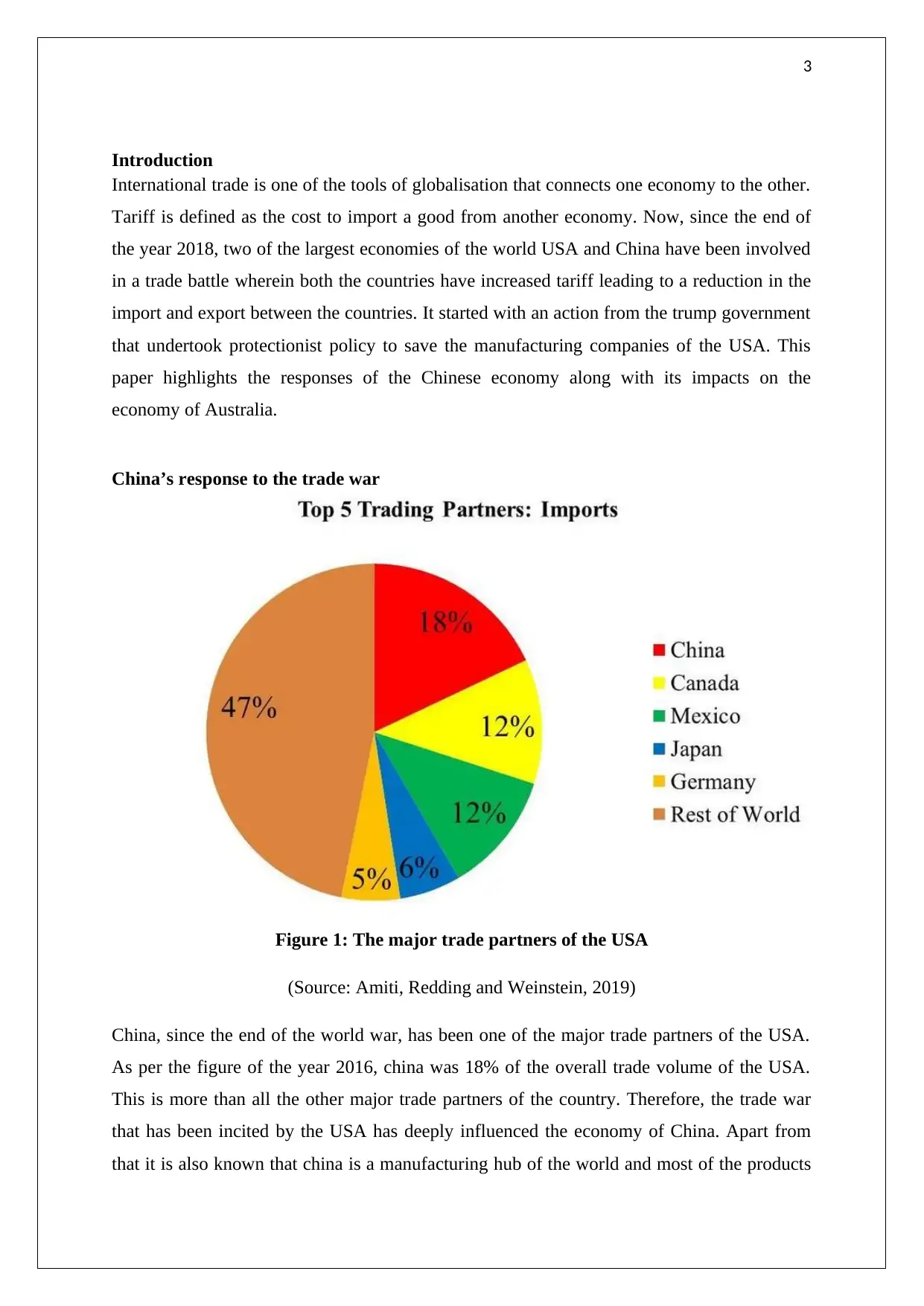
3
Introduction
International trade is one of the tools of globalisation that connects one economy to the other.
Tariff is defined as the cost to import a good from another economy. Now, since the end of
the year 2018, two of the largest economies of the world USA and China have been involved
in a trade battle wherein both the countries have increased tariff leading to a reduction in the
import and export between the countries. It started with an action from the trump government
that undertook protectionist policy to save the manufacturing companies of the USA. This
paper highlights the responses of the Chinese economy along with its impacts on the
economy of Australia.
China’s response to the trade war
Figure 1: The major trade partners of the USA
(Source: Amiti, Redding and Weinstein, 2019)
China, since the end of the world war, has been one of the major trade partners of the USA.
As per the figure of the year 2016, china was 18% of the overall trade volume of the USA.
This is more than all the other major trade partners of the country. Therefore, the trade war
that has been incited by the USA has deeply influenced the economy of China. Apart from
that it is also known that china is a manufacturing hub of the world and most of the products
Introduction
International trade is one of the tools of globalisation that connects one economy to the other.
Tariff is defined as the cost to import a good from another economy. Now, since the end of
the year 2018, two of the largest economies of the world USA and China have been involved
in a trade battle wherein both the countries have increased tariff leading to a reduction in the
import and export between the countries. It started with an action from the trump government
that undertook protectionist policy to save the manufacturing companies of the USA. This
paper highlights the responses of the Chinese economy along with its impacts on the
economy of Australia.
China’s response to the trade war
Figure 1: The major trade partners of the USA
(Source: Amiti, Redding and Weinstein, 2019)
China, since the end of the world war, has been one of the major trade partners of the USA.
As per the figure of the year 2016, china was 18% of the overall trade volume of the USA.
This is more than all the other major trade partners of the country. Therefore, the trade war
that has been incited by the USA has deeply influenced the economy of China. Apart from
that it is also known that china is a manufacturing hub of the world and most of the products
⊘ This is a preview!⊘
Do you want full access?
Subscribe today to unlock all pages.

Trusted by 1+ million students worldwide

4
gets exported to the foreign economies. Thus, the trade war has significantly thrashed the
manufacturing sector of the economy. This had its repercussions in the GDP of the country as
well. The GDP growth rate of china has reduced from a formidable 7.2% in the year 2015 to
a 5.9% in the first quarter of the year 2019.
Therefore, it was inevitable for the government of china to impose some retaliatory tariff on
the products of the USA as well. Hughes and Meckling (2017) stated that, the national
sovereignty and the protection of the respective economy is what led to the escalation of the
war between the two countries. China first responded with an increase in tariff on 128
products that it imports from the USA. These involved products like aluminium, Soya beans,
Cars and many more. Noland (2018) noted that, initially the tariff on these products were
around 15% which were increased to 25% so that; it becomes costlier for the Chinese
importers to bring products from the USA. Despite the initial turmoil, the chief economic
advisor to the president of china Liu He went to Washington to meet USA president Donald
Trump in order to stop the trade war between the two countries. It resulted in a reduction in
the intensity of the trade war as both the countries agreed to reduce the tariff on each other’s
products (Lee, 2018). This was a good relief for both the economies as demand for the
respective export increased in the destination country.
Despite the talks, the president of the USA, announced another 25% tariff on 50 dollar worth
of exports of china into the economy of the USA. This intrigued China to retaliate back and
hence its government imposed another tariff against the products of the USA. According to
Onyusheva, Naing and Zaw (2019), the government of China also made sure that they did not
want to escalate the trade war. In addition to that China internationally also tried to solve the
problem and end the trade war with the USA. After the imposition of enhanced tariff on
Chinese goods, it went to the World trade Organisation (WTO). Zhang (2018) stated that, the
officials from the side of china mentioned that the tariff on Chinese solar products by the
USA were against the rules and the regulations of the WTO. China also filed the second
complaint against the USA in the WTO after the imposition of added tariff on the products of
China. The minister of commerce of China stated that it never wanted a trade war or any
conflict with the USA but in this case, the trade interests of China are being harmed.
Apart from these international responses, the government of China has also undertaken some
of the policies to strengthen the economy internally as well. One of the important internal
decisions by the government of china to combat the ill effects of the trade war has been to
gets exported to the foreign economies. Thus, the trade war has significantly thrashed the
manufacturing sector of the economy. This had its repercussions in the GDP of the country as
well. The GDP growth rate of china has reduced from a formidable 7.2% in the year 2015 to
a 5.9% in the first quarter of the year 2019.
Therefore, it was inevitable for the government of china to impose some retaliatory tariff on
the products of the USA as well. Hughes and Meckling (2017) stated that, the national
sovereignty and the protection of the respective economy is what led to the escalation of the
war between the two countries. China first responded with an increase in tariff on 128
products that it imports from the USA. These involved products like aluminium, Soya beans,
Cars and many more. Noland (2018) noted that, initially the tariff on these products were
around 15% which were increased to 25% so that; it becomes costlier for the Chinese
importers to bring products from the USA. Despite the initial turmoil, the chief economic
advisor to the president of china Liu He went to Washington to meet USA president Donald
Trump in order to stop the trade war between the two countries. It resulted in a reduction in
the intensity of the trade war as both the countries agreed to reduce the tariff on each other’s
products (Lee, 2018). This was a good relief for both the economies as demand for the
respective export increased in the destination country.
Despite the talks, the president of the USA, announced another 25% tariff on 50 dollar worth
of exports of china into the economy of the USA. This intrigued China to retaliate back and
hence its government imposed another tariff against the products of the USA. According to
Onyusheva, Naing and Zaw (2019), the government of China also made sure that they did not
want to escalate the trade war. In addition to that China internationally also tried to solve the
problem and end the trade war with the USA. After the imposition of enhanced tariff on
Chinese goods, it went to the World trade Organisation (WTO). Zhang (2018) stated that, the
officials from the side of china mentioned that the tariff on Chinese solar products by the
USA were against the rules and the regulations of the WTO. China also filed the second
complaint against the USA in the WTO after the imposition of added tariff on the products of
China. The minister of commerce of China stated that it never wanted a trade war or any
conflict with the USA but in this case, the trade interests of China are being harmed.
Apart from these international responses, the government of China has also undertaken some
of the policies to strengthen the economy internally as well. One of the important internal
decisions by the government of china to combat the ill effects of the trade war has been to
Paraphrase This Document
Need a fresh take? Get an instant paraphrase of this document with our AI Paraphraser
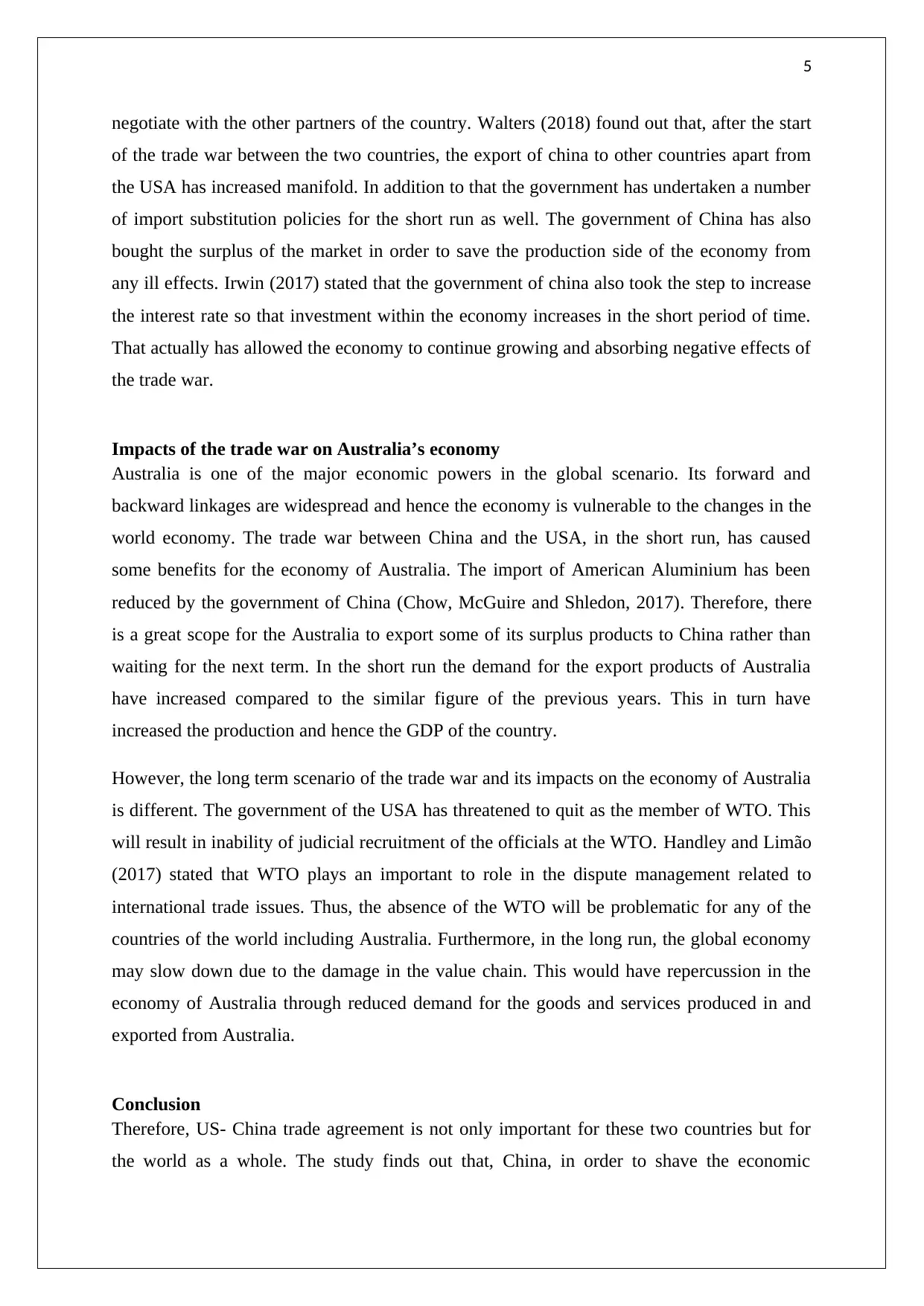
5
negotiate with the other partners of the country. Walters (2018) found out that, after the start
of the trade war between the two countries, the export of china to other countries apart from
the USA has increased manifold. In addition to that the government has undertaken a number
of import substitution policies for the short run as well. The government of China has also
bought the surplus of the market in order to save the production side of the economy from
any ill effects. Irwin (2017) stated that the government of china also took the step to increase
the interest rate so that investment within the economy increases in the short period of time.
That actually has allowed the economy to continue growing and absorbing negative effects of
the trade war.
Impacts of the trade war on Australia’s economy
Australia is one of the major economic powers in the global scenario. Its forward and
backward linkages are widespread and hence the economy is vulnerable to the changes in the
world economy. The trade war between China and the USA, in the short run, has caused
some benefits for the economy of Australia. The import of American Aluminium has been
reduced by the government of China (Chow, McGuire and Shledon, 2017). Therefore, there
is a great scope for the Australia to export some of its surplus products to China rather than
waiting for the next term. In the short run the demand for the export products of Australia
have increased compared to the similar figure of the previous years. This in turn have
increased the production and hence the GDP of the country.
However, the long term scenario of the trade war and its impacts on the economy of Australia
is different. The government of the USA has threatened to quit as the member of WTO. This
will result in inability of judicial recruitment of the officials at the WTO. Handley and Limão
(2017) stated that WTO plays an important to role in the dispute management related to
international trade issues. Thus, the absence of the WTO will be problematic for any of the
countries of the world including Australia. Furthermore, in the long run, the global economy
may slow down due to the damage in the value chain. This would have repercussion in the
economy of Australia through reduced demand for the goods and services produced in and
exported from Australia.
Conclusion
Therefore, US- China trade agreement is not only important for these two countries but for
the world as a whole. The study finds out that, China, in order to shave the economic
negotiate with the other partners of the country. Walters (2018) found out that, after the start
of the trade war between the two countries, the export of china to other countries apart from
the USA has increased manifold. In addition to that the government has undertaken a number
of import substitution policies for the short run as well. The government of China has also
bought the surplus of the market in order to save the production side of the economy from
any ill effects. Irwin (2017) stated that the government of china also took the step to increase
the interest rate so that investment within the economy increases in the short period of time.
That actually has allowed the economy to continue growing and absorbing negative effects of
the trade war.
Impacts of the trade war on Australia’s economy
Australia is one of the major economic powers in the global scenario. Its forward and
backward linkages are widespread and hence the economy is vulnerable to the changes in the
world economy. The trade war between China and the USA, in the short run, has caused
some benefits for the economy of Australia. The import of American Aluminium has been
reduced by the government of China (Chow, McGuire and Shledon, 2017). Therefore, there
is a great scope for the Australia to export some of its surplus products to China rather than
waiting for the next term. In the short run the demand for the export products of Australia
have increased compared to the similar figure of the previous years. This in turn have
increased the production and hence the GDP of the country.
However, the long term scenario of the trade war and its impacts on the economy of Australia
is different. The government of the USA has threatened to quit as the member of WTO. This
will result in inability of judicial recruitment of the officials at the WTO. Handley and Limão
(2017) stated that WTO plays an important to role in the dispute management related to
international trade issues. Thus, the absence of the WTO will be problematic for any of the
countries of the world including Australia. Furthermore, in the long run, the global economy
may slow down due to the damage in the value chain. This would have repercussion in the
economy of Australia through reduced demand for the goods and services produced in and
exported from Australia.
Conclusion
Therefore, US- China trade agreement is not only important for these two countries but for
the world as a whole. The study finds out that, China, in order to shave the economic
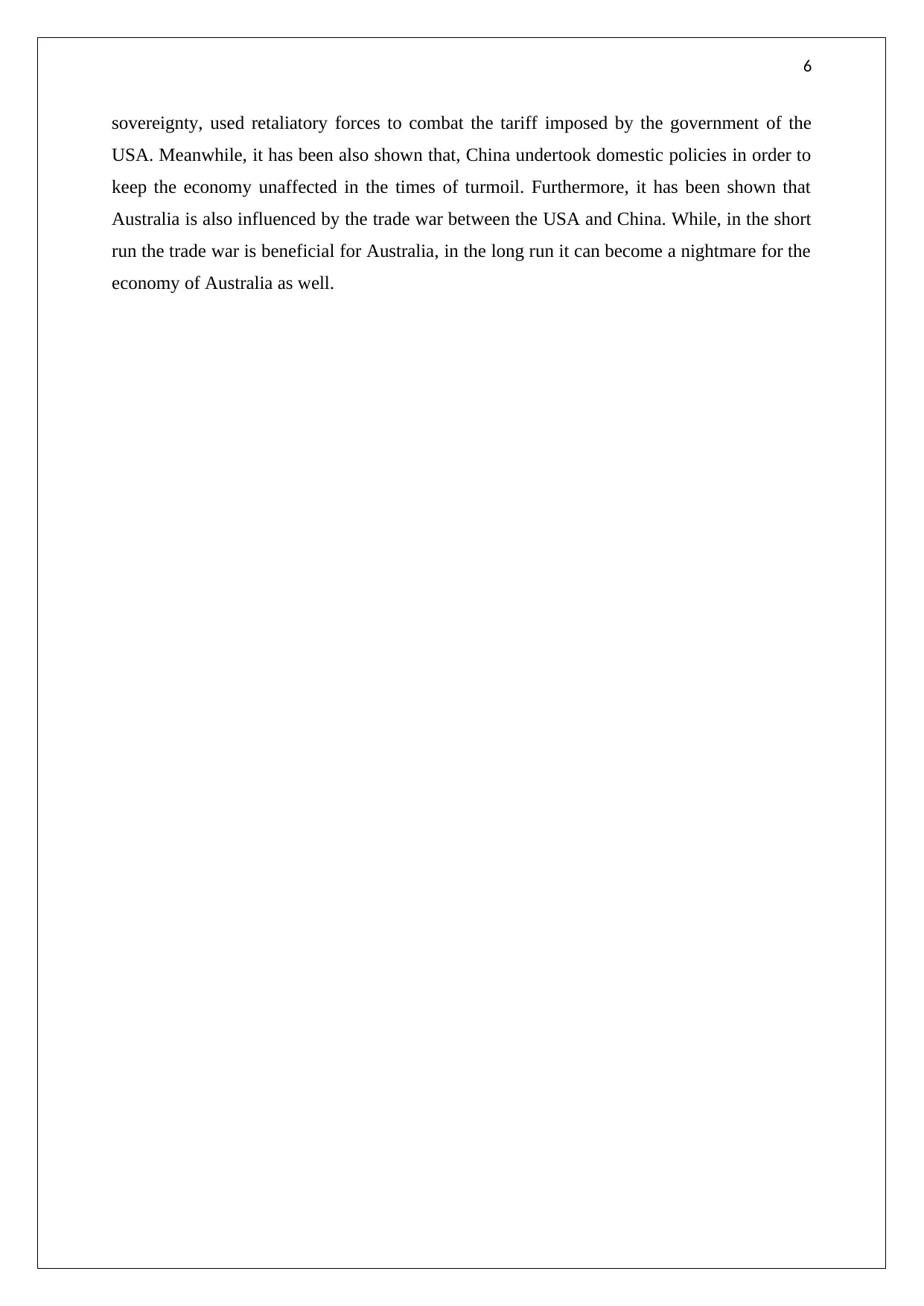
6
sovereignty, used retaliatory forces to combat the tariff imposed by the government of the
USA. Meanwhile, it has been also shown that, China undertook domestic policies in order to
keep the economy unaffected in the times of turmoil. Furthermore, it has been shown that
Australia is also influenced by the trade war between the USA and China. While, in the short
run the trade war is beneficial for Australia, in the long run it can become a nightmare for the
economy of Australia as well.
sovereignty, used retaliatory forces to combat the tariff imposed by the government of the
USA. Meanwhile, it has been also shown that, China undertook domestic policies in order to
keep the economy unaffected in the times of turmoil. Furthermore, it has been shown that
Australia is also influenced by the trade war between the USA and China. While, in the short
run the trade war is beneficial for Australia, in the long run it can become a nightmare for the
economy of Australia as well.
⊘ This is a preview!⊘
Do you want full access?
Subscribe today to unlock all pages.

Trusted by 1+ million students worldwide
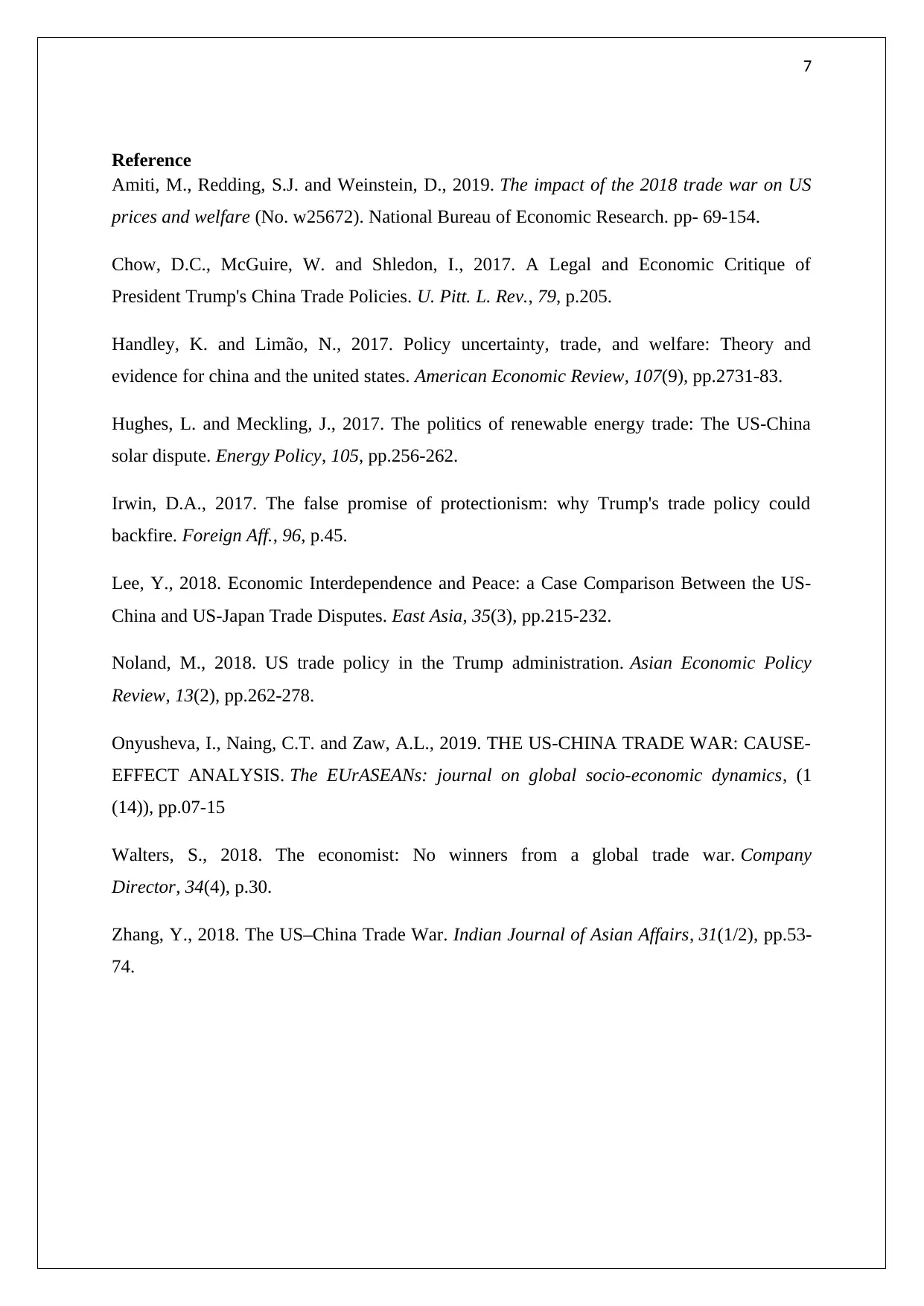
7
Reference
Amiti, M., Redding, S.J. and Weinstein, D., 2019. The impact of the 2018 trade war on US
prices and welfare (No. w25672). National Bureau of Economic Research. pp- 69-154.
Chow, D.C., McGuire, W. and Shledon, I., 2017. A Legal and Economic Critique of
President Trump's China Trade Policies. U. Pitt. L. Rev., 79, p.205.
Handley, K. and Limão, N., 2017. Policy uncertainty, trade, and welfare: Theory and
evidence for china and the united states. American Economic Review, 107(9), pp.2731-83.
Hughes, L. and Meckling, J., 2017. The politics of renewable energy trade: The US-China
solar dispute. Energy Policy, 105, pp.256-262.
Irwin, D.A., 2017. The false promise of protectionism: why Trump's trade policy could
backfire. Foreign Aff., 96, p.45.
Lee, Y., 2018. Economic Interdependence and Peace: a Case Comparison Between the US-
China and US-Japan Trade Disputes. East Asia, 35(3), pp.215-232.
Noland, M., 2018. US trade policy in the Trump administration. Asian Economic Policy
Review, 13(2), pp.262-278.
Onyusheva, I., Naing, C.T. and Zaw, A.L., 2019. THE US-CHINA TRADE WAR: CAUSE-
EFFECT ANALYSIS. The EUrASEANs: journal on global socio-economic dynamics, (1
(14)), pp.07-15
Walters, S., 2018. The economist: No winners from a global trade war. Company
Director, 34(4), p.30.
Zhang, Y., 2018. The US–China Trade War. Indian Journal of Asian Affairs, 31(1/2), pp.53-
74.
Reference
Amiti, M., Redding, S.J. and Weinstein, D., 2019. The impact of the 2018 trade war on US
prices and welfare (No. w25672). National Bureau of Economic Research. pp- 69-154.
Chow, D.C., McGuire, W. and Shledon, I., 2017. A Legal and Economic Critique of
President Trump's China Trade Policies. U. Pitt. L. Rev., 79, p.205.
Handley, K. and Limão, N., 2017. Policy uncertainty, trade, and welfare: Theory and
evidence for china and the united states. American Economic Review, 107(9), pp.2731-83.
Hughes, L. and Meckling, J., 2017. The politics of renewable energy trade: The US-China
solar dispute. Energy Policy, 105, pp.256-262.
Irwin, D.A., 2017. The false promise of protectionism: why Trump's trade policy could
backfire. Foreign Aff., 96, p.45.
Lee, Y., 2018. Economic Interdependence and Peace: a Case Comparison Between the US-
China and US-Japan Trade Disputes. East Asia, 35(3), pp.215-232.
Noland, M., 2018. US trade policy in the Trump administration. Asian Economic Policy
Review, 13(2), pp.262-278.
Onyusheva, I., Naing, C.T. and Zaw, A.L., 2019. THE US-CHINA TRADE WAR: CAUSE-
EFFECT ANALYSIS. The EUrASEANs: journal on global socio-economic dynamics, (1
(14)), pp.07-15
Walters, S., 2018. The economist: No winners from a global trade war. Company
Director, 34(4), p.30.
Zhang, Y., 2018. The US–China Trade War. Indian Journal of Asian Affairs, 31(1/2), pp.53-
74.
1 out of 7
Related Documents
Your All-in-One AI-Powered Toolkit for Academic Success.
+13062052269
info@desklib.com
Available 24*7 on WhatsApp / Email
![[object Object]](/_next/static/media/star-bottom.7253800d.svg)
Unlock your academic potential
Copyright © 2020–2025 A2Z Services. All Rights Reserved. Developed and managed by ZUCOL.





